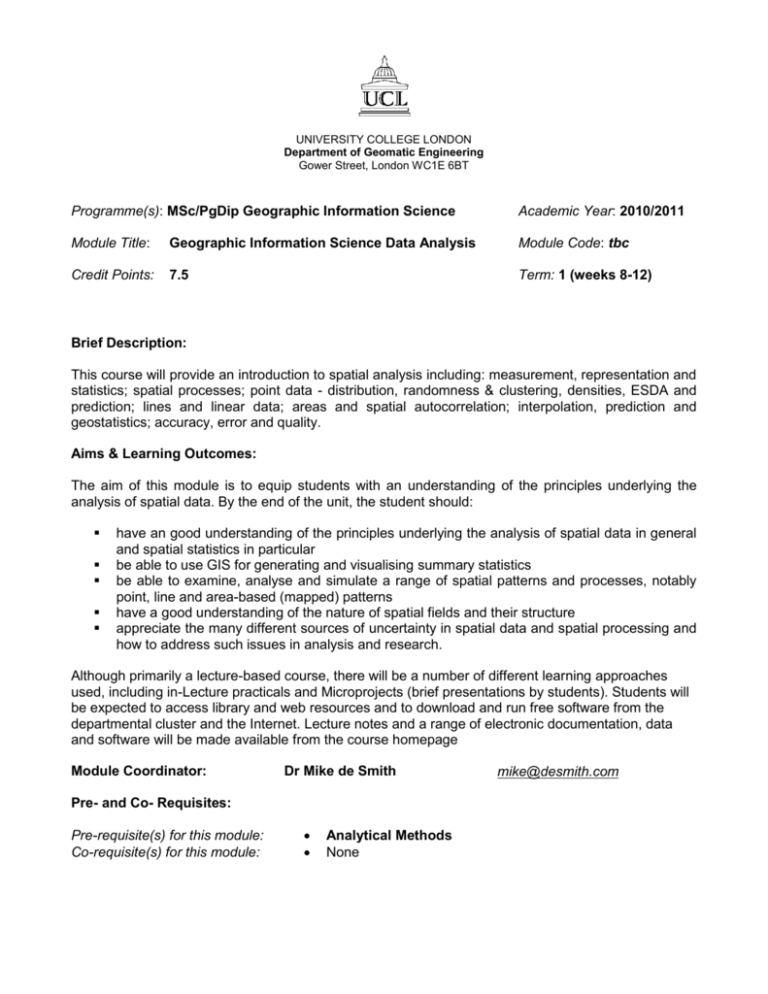gda cegeg053 mg 10-1.. - UCL Department of Geography
advertisement

UNIVERSITY COLLEGE LONDON Department of Geomatic Engineering Gower Street, London WC1E 6BT Programme(s): MSc/PgDip Geographic Information Science Academic Year: 2010/2011 Module Title: Geographic Information Science Data Analysis Module Code: tbc Credit Points: 7.5 Term: 1 (weeks 8-12) Brief Description: This course will provide an introduction to spatial analysis including: measurement, representation and statistics; spatial processes; point data - distribution, randomness & clustering, densities, ESDA and prediction; lines and linear data; areas and spatial autocorrelation; interpolation, prediction and geostatistics; accuracy, error and quality. Aims & Learning Outcomes: The aim of this module is to equip students with an understanding of the principles underlying the analysis of spatial data. By the end of the unit, the student should: have an good understanding of the principles underlying the analysis of spatial data in general and spatial statistics in particular be able to use GIS for generating and visualising summary statistics be able to examine, analyse and simulate a range of spatial patterns and processes, notably point, line and area-based (mapped) patterns have a good understanding of the nature of spatial fields and their structure appreciate the many different sources of uncertainty in spatial data and spatial processing and how to address such issues in analysis and research. Although primarily a lecture-based course, there will be a number of different learning approaches used, including in-Lecture practicals and Microprojects (brief presentations by students). Students will be expected to access library and web resources and to download and run free software from the departmental cluster and the Internet. Lecture notes and a range of electronic documentation, data and software will be made available from the course homepage Module Coordinator: Dr Mike de Smith Pre- and Co- Requisites: Pre-requisite(s) for this module: Co-requisite(s) for this module: Analytical Methods None mike@desmith.com Teaching Outlines: Week: AM/PM: 7 AM PM AM 8 PM AM 9 PM AM 10 PM Content: ----Basic Concepts: Measurement, representation and statistics Introduction to module structure, aims and objectives; Introduce/review core concepts of measurement and statistics as a precursor to studying spatial statistics and spatial analysis methods, including descriptive statistics and univariate distributions, simple regression Introduction to Spatial Processes and Spatial Analysis Introduction to formal methods and tools of spatial analysis: pattern, process, dimensionality, MAUP, spatial statistics and GIS toolsets, brushing and linking; classification and mapping; microprojects programme Point data: Distribution, randomness & clustering Examine measures of spatial centrality and dispersion; simple indices and tests for randomness; quadrat and NN methods, Ripley’s K Point data: Densities, ESDA and prediction Introduction to density estimation, hotspot analysis, kernels and ESDA, control and covariate data; point/region duality; temporal analysis Lines and linear data Microproject: MP1a Obtain a better understanding of notion of ‘line’, network and associated representation and analysis issues and methods, including alternative conceptual models (mathematical, statistical, fractal..), metrics and measurement, and additional properties of linear forms Network analysis; Microprojects: MP1b Collections of linear forms as networks; representation as graphs, trees and circuits; simple optimisation problems and solutions Duration: Staff: Room Type: (i.e. Lecture/Practical) 3 Hours MdS GE Classroom/GE Computer Cluster 3 Hours MdS GE Classroom/GE Computer Cluster 3 Hours MdS GE Classroom/GE Computer Cluster 3 Hours MdS GE Classroom/GE Computer Cluster 3 Hours MdS GE Classroom/GE Computer Cluster 3 Hours MdS GE Classroom/GE Computer Cluster Week: AM/PM: AM 11 PM AM 12 PM Content: Areas and Spatial Autocorrelation Microproject: MP2a Obtain a basic understanding of nonstationary processes, anisotropy and autocorrelation analysis: area analysis and landscape metrics; joins counts; Moran’s I and Geary C Interpolation, prediction & Geostatistics 1; Microprojects: MP2b Obtain an understanding of fields and creation/estimation of (continuous) fields from point and other datasets - deterministic procedures (e.g. IDW and splines); discussion of surface attributes (e.g. gradient, aspect, roughness…) Interpolation, prediction & Geostatistics 2; Microproject: MP3a Obtain an understanding of fields and creation/estimation of (continuous) fields from point and other datasets - statistical procedures (e.g. simple regression, GWR, and kriging) Accuracy, Error and Quality Microprojects: MP3b Obtain an appreciation of the types and sources of error; examination of how to deal with uncertainty; followed by a review of the Analysis module and role of analysis Duration: Staff: Room Type: (i.e. Lecture/Practical) 3 Hours MdS GE Classroom/GE Computer Cluster 3 Hours MdS GE Classroom/GE Computer Cluster 3 Hours MdS GE Classroom/GE Computer Cluster 3 Hours MdS GE Classroom Marking: Will be by coursework submission. Coursework will be set in week 9 and must be completed by end of week 12.







